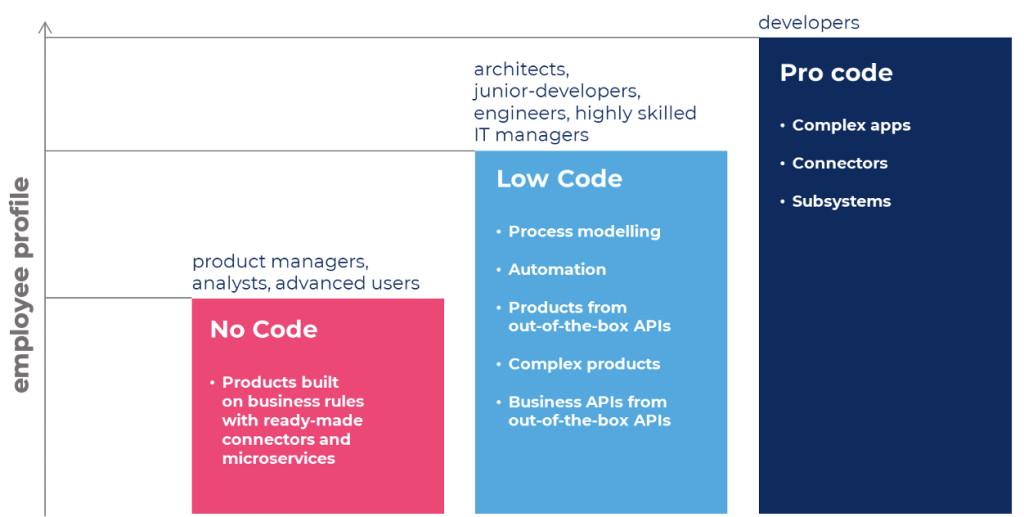
Hybrid approach and its advantages over the standard low-code development
The accelerated development of digital businesses throughout the world encourages companies to take prompt decisions. A spike in remote development during the COVID-19 pandemic triggered the spread of low-code tools and made it common to encourage so-called “citizen developers” to work on projects. They are either beginner programmers or employees with no corresponding formal training who have learned to configure applications through specific solutions.
Reputable research agencies, such as Gartner, forecast the stable growth of the low-code development technologies market, emphasizing changes in the paradigm and ongoing cost optimization efforts.
In Russia, the trend was further reinforced by import substitution projects when businesses had to suddenly abandon their standard solutions and search for alternatives among the developments tools offered on the domestic market. The processes associated with vendor support for existing solutions also became more complicated. Organizations that employed their own IT staff were in a slightly stronger position. This dispelled the misconception that pro-coding was becoming less in demand owing to “civilian developers”. Yet even such major players are aware of the additional benefit they can derive fr om low-code capabilities.
Being an IT company with 26 years of expertise in building products for business development, Bercut long ago recognized that low-code could indeed simplify part of business processes and accelerate digital transformation. Nevertheless, focusing only on one development approach can negatively affect the prospects of business development.
Playing the long game, it is necessary to take a balanced approach to the situation — not just plugging the leaks but building your long-term strategy on solid ground in a highly turbulent market.
There are many events taking place today wh ere companies share their experience in implementing short-term cases. At one of such events we spoke about the nature of the hybrid approach and its advantages over the standard low-code development.
Hybrid ApproachIn developing software products, Bercut always aims to accelerate implementation, reduce labor costs and yet preserve the quality, since our partners are the largest mobile network operators and service providers in Russia, the CIS countries, Europe, and Africa. Over 300 million end users enjoy services based on Bercut solutions.
Over 1000 installations of Bercut solutions throughout the world.
For this reason, Bercut decided to build its own platform for developing integration services that was later named the Hybrid Integration Platform by Bercut (Hybrid Integration Platform, HIP).
The hybrid nature of the platform is that HIP is actually a system of software products. Applying different elements of the platform and combining them allows solving the following key issues of digital transformation:
• integrations;
• creation of new products and MVPs;
• standardization of the IT landscape;
• automation of business processes;
and other business-related issues.
There are different levels for users working with the platform: no-code, low-code, and pro-code. Users can choose a set of frameworks depending on the issues to be solved. The user’s level depends on their competencies and skills.

Ready-to-use no-code and low-code tools in the HIP — microservices for business logic scripting and ready-to-use connectors for integrations — minimize routine processes. Developers do not need to puzzle over scaling, production, logging, setting storage, or the transport layer — all of this is already incorporated in the platform.
You can create any missing microservice or connector at the pro-code level. Multiple re-use of platform artifacts allows reproducing a once-created product or develop a new one through its custom modifications even decades later.
Therefore, HIP is a perfect solution for IT leaders who are required to greatly accelerate the delivery of new products and reduce the payback period even with few advanced developers among their staff.
Using HIP, Bercut has reduced the time-to-market by 30% and brought down the prime costs of development by 15–30% depending on the project complexity.
Low-code vs. Hybrid Approach
The advantages of low-code become evident on the example of a case related to personal communications. We were tasked with creating a subscriber notification system for a mobile network operator. Notifications were supposed to be delivered through various channels, which was later complemented by targeted advertising as a system functionality.
The use of low-code on the HIP basis became an effective solution satisfying the partner’s needs. We provided the partner with the following:
1. Accessible web interface for quick parameter changes by the business user.
2. A set of ready-made connectors to the subscriber data storage systems.
3. A set of ready-made microservices to build products.
This helped automate some of the routine processes that previously involved the partner's IT staff. The time to make changes to the business logic, which had taken up to two weeks, was reduced to 30 minutes.
Yet low-code capabilities may sometimes be insufficient, and the earlier the company considers alternative development tools, the more efficient its workflow will be in the future.
Case: Developing the Ecosystem of Partner Products
Sometimes it is simply a promising idea that triggers the launch of a project, and the time to bring it to life is limited. This was the case here.
Everything we had at the start of the project was a list of 20 companies interested in building digital products together with our partner. We had to give the client the opportunity to combine the client’s own products with the offers fr om the partners we knew. Apart from that, it was also important to provide for the expansion of the ecosystem. It means that new partners could join the system, in which case quick and flexible changes in business processes would be required. Such prospects made integration options unclear, and this was an impossible challenge for low-code. Low-code cannot go beyond certain limits.
Disadvantages of Low-code
There is no doubt that low-code tools can simplify some specific processes and reduce time-to-market. Yet, differently from hybrid platforms, they have certain disadvantages, the main of them being the absence of pro-code capabilities. Technical restrictions on settings, customization and integration capabilities challenge flexibility that is so important in a dynamic market, while specific requirements for the interface, load, and security incur additional costs, imposing certain risks on a company.
Other than that, using exclusively low-code solutions, business users do not acquire new skills, the demand for IT developers declines, and their competencies deteriorate. Thus, the complexity and specific features of some platforms make companies dependent on vendors, with every new project involving interaction with them.
Conclusion
To conclude, I feel like speaking in favor of low-code. Nevertheless, in my view, it is more efficient as part of a hybrid integration platform. Do not lim it yourself, take the best from different approaches.
You may have different goals and ways to achieve them, it is impossible to plan it all. Yet if you play the long game, it is better to have all the necessary tools at your disposal. As one Latin proverb goes, “If the wind will not serve, take to the oars.”


